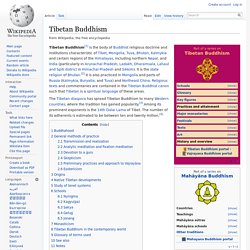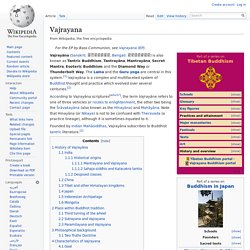

Tibetan Buddhism. Tibetan Buddhism[1] is the body of Buddhist religious doctrine and institutions characteristic of Tibet, Mongolia, Tuva, Bhutan, Kalmykia and certain regions of the Himalayas, including northern Nepal, and India (particularly in Arunachal Pradesh, Ladakh, Dharamsala, Lahaul and Spiti district in Himachal Pradesh and Sikkim).

It is the state religion of Bhutan.[2] It is also practiced in Mongolia and parts of Russia (Kalmykia, Buryatia, and Tuva) and Northeast China. Religious texts and commentaries are contained in the Tibetan Buddhist canon such that Tibetan is a spiritual language of these areas. The Tibetan diaspora has spread Tibetan Buddhism to many Western countries, where the tradition has gained popularity.[3] Among its prominent exponents is the 14th Dalai Lama of Tibet. The number of its adherents is estimated to be between ten and twenty million.[4] Buddhahood[edit] General methods of practice[edit] Transmission and realization[edit] Devotion to a guru[edit] Skepticism[edit]
Dzogchen. According to Tibetan Buddhism and Bön, Dzogchen (Rdzogs chen or Atiyoga) is the natural, primordial state or natural condition, and a body of teachings and meditation practices aimed at realizing that condition.

Dzogchen, or "Great Perfection", is a central teaching of the Nyingma school also practiced by adherents of other Tibetan Buddhist sects. According to Dzogchen literature, Dzogchen is the highest and most definitive path to enlightenment.[1] From the perspective of Dzogchen, the ultimate nature of all sentient beings is said to be pure, all-encompassing, primordial clarity or naturally occurring timeless clarity. This intrinsic clarity has no form of its own and yet is capable of perceiving, experiencing, reflecting, or expressing all form. It does so without being affected by those forms in any ultimate, permanent way. Nomenclature and etymology[edit] Maha Ati[edit] Esoteric transmission[edit] Background[edit] Indian originators[edit] Prahevajra (Tib.
Tibet[edit] Padmasambhava (Tib.
Vajrayana. Vajrayāna (Sanskrit: वज्रयान, Bengali: বজ্রযান) is also known as Tantric Buddhism, Tantrayāna, Mantrayāna, Secret Mantra, Esoteric Buddhism and the Diamond Way or Thunderbolt Way.

The Lama and the Guru yoga are central in this system.[1] Vajrayāna is a complex and multifaceted system of Buddhist thought and practice which evolved over several centuries. Founded by Indian Mahāsiddhas, Vajrayāna subscribes to Buddhist tantric literature. History of Vajrayāna[edit] Although the first tantric Buddhist texts appeared in India in the 3rd century and continued to appear until the 12th century, scholars such as Hirakawa Akira assert that the Vajrayāna probably came into existence in the 6th or 7th century, while the term Vajrayāna itself first appeared in the 8th century.
The Vajrayāna was preceded by the Mantrayāna, and then followed by the Sahajayāna and Kalacakrayāna. India[edit] Historical origins[edit] Mantrayana and Vajrayana[edit] The earliest texts appeared around the early 4th century. Tibetan Buddhism Archives. Om Mani Padme Hum: The Meaning of the Mantra in Tibetan Buddhism.
Glimpsing a Few More Facets of the Mantra There are many ways to understand the meaning of the mantra.

Here are a few of them: The Transformation of Speech [An excerpt from The Dharma, by Kalu Rinpoche, from a chapter on The Four Dharmas of Gampopa. ] "The second aspect of transformation [of confusion into wisdom] concerns our speech. Mere words, which have no ultimate reality, can determine our happiness and suffering. In the Vajrayana context, we recite and meditate on mantra, which is enlightened sound, the speech of the [Bhodisattva of Compassion], the union of Sound and Emptiness. At first, the Union of Sound and Emptiness is simply an intellectual concept of what our meditation should be. One of the disciples was very diligent, though his realization was perhaps not so profound. When the two disciples went to their lama to indicate they had finished the practice, he said, 'Oh, you've both done excellently. The Powers of the Six Syllables "Behold! H.H. Top of page. Mantra. LamRim.com - Tibetan Buddhist Internet Radio.
Guélougpa. Sakyapa. Kagyüpa.